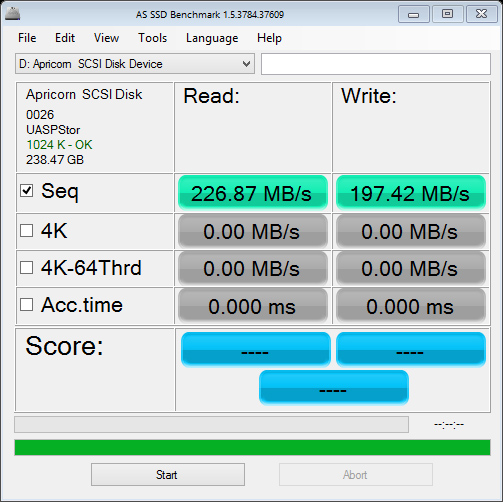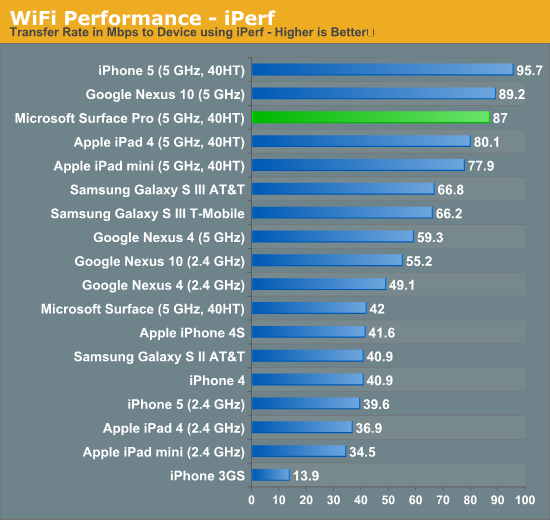Microsoft Surface Pro Review
by Anand Lal Shimpi on February 5, 2013 9:00 PM ESTFans and Thermals
While Surface RT was passively cooled, Surface Pro features two integrated fans to cool the 17W Core i5-3317U. For most light use cases, those two fans will remain spun down and you can’t hear them. Do any sort of serious multitasking or start using Surface Pro as a real PC instead of a tablet and you’ll quickly hear them spin up. Fan noise is audible but not annoying - it’s very similar to the sound you’d hear out of any ultraportable with a couple of tiny fans spinning up.
In landscape mode with the Type Cover attached, Surface Pro draws in cool air from the sides and exhausts it out of the top of the device. Rotate the device into portrait mode and the fans will switch directions, drawing in cool air from the long edge and exhausting it out of the short edges. The fan direction switch is triggered in tandem with display rotation, so as soon as you see your display rotate you’ll hear the fans change direction.
The two fans do a good job keeping the CPU cool (I saw typical CPU core temperatures between 50C - 60C), but Surface Pro does get warm. I measured a max surface temperature of 41.8C while running 3DMark 11. That’s towards the top of the unit, around where the Core i5 CPU is located. On the edges I measured a max surface temperature of 36.5C. There’s no getting around the fact that Surface Pro gets warm, noticeably more so than the 4th generation iPad. It never gets uncomfortably hot however.

Despite being a tablet, the Core i5-3317U had no issues hitting its max turbo frequency of 2.6GHz. I even saw 2.75GHz for a very short period of time (remember, Intel’s Turbo Boost can exceed max TDP until the silicon gets up to temperature).
Storage and USB 3.0
Surface Pro ships with a micro SDXC slot along the edge of the device. Courtesy of Intel’s HM77 chipset, you also get a full blown 6Gbps SSD and a single USB 3.0 port - both significant upgrades over Surface RT. In my 128GB review sample, Surface Pro features a Micron C400 SSD. Microsoft is sourcing from multiple SSD vendors and claims to be shipping with optimized firmware, but I don’t know what other vendors are in the mix. Update: It looks like the C400 SSD is an mSATA drive, likely similar to the one we reviewed here a while back.

To put this in perspective, the C400 is in the same class of storage device that’s used in Apple’s MacBook Air. Although some ARM based SoCs feature SATA interfaces, pretty much all of them are paired with eMMC based NAND storage solutions that are horribly slow. The fastest sequential transfer rates I’ve managed on the 4th generation iPad are typically on the 20 - 30MB/s range, whereas the C400 in the Surface Pro is good for over 400MB/s in reads and just under 200MB/s in writes.

There’s been a lot of debate over the amount of free space available on Windows RT/8 tablets fresh out of the box. My 128GB review sample was partitioned down to 110GB with roughly 8GB used for the recovery partition. Of that 110GB, 89.5GB was free space that remained. I don’t really view this as false advertising by Microsoft (both Macs and PCs have been sold like this for decades), but you do need to know what you’re getting into here. Given the already high price of these systems and the relatively small price differential between a 64GB Surface Pro and a 128GB model, I’d recommend going for the latter. Microsoft claims something like 29GB of free space remains on the 64GB model - enough for some apps and data, but keep in mind like all solid state storage you don’t want to completely fill up your drive either (this is also true for ARM based tablets like the iPad).
USB 3.0 is equally as impressive on Surface Pro. Using a simple USB 3.0 to SATA adapter I could easily read and write at around 200MB/s. Compare this to the ~20MB/s you get on most ARM based tablets and it’s obvious that this Surface deserves its Pro moniker.

Ultimately Surface Pro’s storage subsystem is a big part of what separates it from the current crop of ARM based tablets. While it’s possible to run productivity workloads on many tablets these days, there’s truly very little that separates what you can do on Surface Pro with what what you can do on a conventional PC.
WiFi Performance
Similar to Surface RT, Surface Pro uses a 2x2 802.11n WiFi controller from Marvell. I believe this is likely the same Marvell Avastar 88W8797 WiFi solution, but connected over USB instead of SDIO.
WiFi performance is appreciably better than on Surface RT, connected to a 5GHz 802.11n network I was able to pull a maximum of 87Mbps compared to 42Mbps on Surface RT. This is competitive with what I’ve seen on other high-end tablets based on ARM architectures, although lower than what I’ve gotten out of a MacBook Air.

WiFi range is subjectively really good on Surface Pro and a lot better than most ARM based tablets I’ve played with. I ran an iperf test on an iPad 4 and Surface Pro around 100 feet away from an AP through several walls and saw roughly an order of magnitude better performance out of the Surface Pro (8 - 10Mbps vs. 0.95 Mbps).
While peak WiFi performance out of Surface Pro is similar to a high-end tablet, worst case performance is more like a good notebook. Overall I’m pleased with the wireless stack on Surface Pro.










228 Comments
View All Comments
kyuu - Thursday, February 7, 2013 - link
Lol? You only agree with Anand when he gives glowing reviews of Apple products.chizow - Wednesday, February 6, 2013 - link
I really like the idea behind Surface, but it just needs some refinement and improvements in hardware that only time and process fabrication brings.20% faster CPU speed, 50% better battery life, 40% smaller form factor, and 25% lower price ($700-750 range with a cover included) and I think Microsoft has a real winner here. Hopefully they aren't scared away by the RT's lackluster sales and stay on course with consistent upgrades for Surface.
I think the only questions now are...whether Microsoft will follow the insane 10-12 month upgrade cycle behind tables/smartphones, or the longer 18-24 month cycles of CPU/GPU. Or maybe they go the silent upgrade route similar to Alienware and Apple with their laptop offerings. Just silently upgrade components within the same model with major changes every few years.
I personall hope they go with the tablet/smartphone upgrade path because that means we'll get faster upgrades and increases in performance.
Jaerba - Wednesday, February 6, 2013 - link
Go on Newegg right now and find a laptop, any laptop regardless of size, that has 1080p resolution, a 100GB+ SSD and an i5 or i7. The closest you'll get are refurbed Zenbooks, and the rest are $1500+ offerings from Lenovo, Asus, Sony, etc.The pricing is simply not the issue, especially for the business user market. It's completely fair given the components.
chizow - Thursday, February 7, 2013 - link
Wrong, low power, small form factor Ultrabooks are in the same price range and even use most of the same components down to the CPU. Afterall, Microsoft is limited to common components and didn't get any special consideration from Intel for Surface.http://www.shopping.hp.com/en_US/home-office/-/pro...
As for the pricing, I'm not sure why you are comparing to Ultrabook, might as well compare it to the Titanic. Microsoft's entire reason for coming out with the Surface was to bridge the gap between the PC and tablet/mobile platforms, but in order to offer an appealing alternative, they can't price it like a PC, otherwise they'll share the same fate with that dying market.
Surface is going to compete against $200-$500 smart phones and tablets, not $1000-$1500 Ultrabooks, and as such, it needs to get closer to that $200-$500 price point.
althaz - Thursday, February 7, 2013 - link
I'm actually a lot more ok with the price than I am with some of the other compromises (but I accept most of them as nessecary for now).I think $799 for the 128Gb with a touch cover would be the perfect price and I DEFINITELY think the touch cover should be included in the $999 price, but at the end of the day it's certainly a FAIR price.
It's just not a great or even GOOD price.
kyuu - Thursday, February 7, 2013 - link
Comparing it with iOS and Android tabs is just ludicrous. It's not even in the same class of device. The tablet form factor does not dictate a low-performance, low-price device just because that's what you're used to.I would agree with Anand that a touch-/type-cover should be included for the price, though.
andrewaggb - Thursday, February 7, 2013 - link
agreed. Like anand said, the intel cpu alone is more than a nexus 7.And it uses a real SSD with 400MB/s reads, not emmc with 30MB/s.
It's not a great deal, but it's not a ripoff either. I don't consider price the issue at all on this one.
Surface RT on the other hand is overpriced.
chizow - Thursday, February 7, 2013 - link
No, it's not in the same class as iOS or Android devices in terms of hardware or even app/content compatibility, but that's the market it is competing with or hoping to cannibilize. People who want a portable cross-over device that gives them the flexibility and mobility of their tablets and smartphones with the power of their laptop/ultrabook.People will be asking themselves if they want to spend $200-400 on a iOS/Android tablet and a $500-600 laptop OR if they want to spend $1000 on a Surface + type pad. Many will find the combination of 2 devices suits their needs better than the Jack of all trades Master of None approach of the Surface.
Does the Surface do a good job of hitting it's mark? Yes. Does it do a good enough job to make you ditch your tablet/handheld OR your Ultrabook, or both? Probably not. It's not quite yet there in form factor, performance or price, imo. But I guess we will see how the market responds. I think it needs to drop to $700-$800 before it really takes off with at least 1 iteration of hardware improvements.
Doominated - Thursday, February 7, 2013 - link
Comparisons are made off of what the device can do, not what it looks like. What the Surface Pro does is in line with Ultrabooks, not with tablets. It just happens to look like a tablet.If you buy a mini-fridge that looks like a TV, are you going to start comparing it to TVs and what they can do, or to what mini-fridges can do? It's a pretty obvious answer.
chizow - Thursday, February 7, 2013 - link
What a device can do and what it looks like are integral to one another as form and function are synonymous. The edge the Surface has over other devices however is with content, applications and performance, you can get better compatibility and functionality in this regard but then you lose the tablet form factor and end up with an Ultrabook in terms of form factor and pricing.Ultimately, this device is going to be compared to tablets and smartphones because that's where the industry is going. Smaller, portable, handheld, easy to use, touch friendly devices. That's why the Surface exists, if not, we'd all be buying Ultrabooks. How many of you own Ultrabooks...how many of you want one?